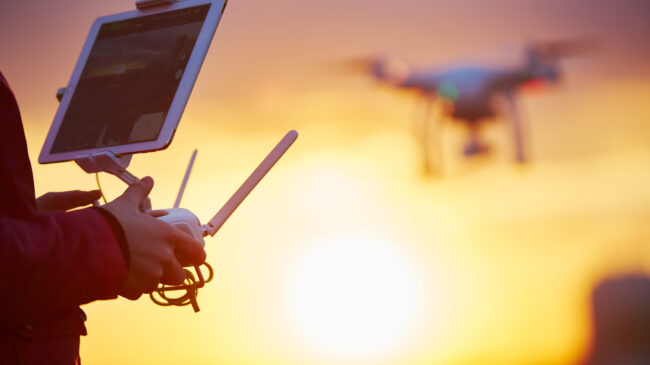Later this summer, congressional aviation staff are expected to begin initial discussions on a reauthorization of the Federal Aviation Administration (FAA), which is due at the end of Sept. 2023. One topic that Congress will consider is the integration of drones into the National Airspace System. This is a long-term effort that will require overcoming numerous technical and policy challenges, many of which cannot be addressed in time for next year’s FAA reauthorization. To ensure it acts in the public interest, Congress should pay close attention to ongoing activities in the drone industry and at FAA, which were both highlighted at a recent conference.
The general mood at the 2022 FAA Drone Symposium, held in Orlando earlier this year, was one of cautious optimism. FAA officials pledged their strong support for emerging drone technologies. Industry representatives praised recent airspace integration activities, chiefly the final report from FAA’s Unmanned Aircraft Systems (UAS) Beyond Visual Line of Sight Aviation Rulemaking Committee. Both sides noted, however, that the ultimate goal of fully integrating UAS into the National Airspace System (NAS) will take many years to achieve.
During a panel surveying UAS operations and policy around the world, Philip M. Kenul, from the F38 UAS Committee of ASTM International (formerly the American Society for Testing and Materials), noted that work on international regulatory harmonization is ongoing but remains at the early stages. Mr. Kenul suggested that industry consensus standards can guide coordination between national and multinational (in the case of the European Union) aviation regulators.
Kenul highlighted remote UAS identification and UAS traffic management (UTM) as examples of standardization activities that are aimed at building both industry and regulatory consensus. ASTM’s remote ID standard (ASTM F3411-19) was originally adopted in 2019 and has since been updated to accommodate both FAA and European remote ID regulations. ASTM’s technical standard for promoting interoperability across providers of UAS traffic management (ASTM F3548-21) aims to similarly bridge UTM development activities from both commercial developers and regulators. This iterative process, coupled with industry and government feedback loops, can allow varied stakeholders to keep up with this rapidly evolving environment while avoiding the downsides of path dependence that come from an overly prescriptive, regulator-centric approach.
Alongside coordination through standards bodies such as ASTM and the International Organization for Standardization, Leslie Cary from the International Civil Aviation Organization (ICAO) said ICAO is working to develop comprehensive guidance on cross-border UAS operations among member states. However, formal recommendations will not be immediately forthcoming.
Asked to predict the next five-to-10 years of UAS airspace integration developments around the world, Kenul demurred, saying past predictions on the specific timing of airspace integration events have been completely wrong. ICAO’s Cary offered the safe prediction that collaboration and coordination will continue.
While a bit unwieldy, the 10-person stakeholder panel on FAA’s Beyond Visual Line of Sight (BVLOS) Aviation Rulemaking Committee (ARC) final report offered insight into current thinking on the next major step toward full integration of UAS into the NAS. Jim Williams of AURA Network Systems lamented that excessive attention on the few areas of stakeholder disagreement—notably the recommendation that UAS be granted right-of-way over crewed aircraft in certain low-altitude contexts—is overshadowing the fact that the vast majority of the more than 70 recommendations enjoyed broad consensus. As FAA moves forward with a BVLOS rulemaking, Williams said it should take care not to “throw the baby out with the bathwater.”
This issue is very important to UAS stakeholders and they are likely to express strong views on it during the forthcoming rulemaking process. Lisa Ellman of the Commercial Drone Alliance emphasized that the right-of-way issue is incredibly important to the UAS industry and is a major reason why large-scale commercial operations are not taking place in the United States. Whatever FAA ultimately decides to do about rights-of-way, the rules should be clear for all NAS users and enforced consistently.
UAS traffic management (UTM) also remains a top priority of drone stakeholders. The most recent version of FAA’s UTM Concept of Operations (ConOps) was released in 2020. The third version, originally slated for a second quarter 2021 release, has been delayed until at least the end of 2022 according to a March 2022 FAA UTM Field Test project presentation to the industry. While the revised UTM ConOps will reflect the final UAS remote ID rule that was published in January 2021, it is unclear if the timing will allow it to reflect FAA’s thinking—at least their initial thinking at the proposed rule stage—on the BVLOS regulatory framework. In any event, it is clear that a fourth version of the UTM ConCops will be needed to fully account for permissible BVLOS operations.
Tim Arel, acting chief operating officer of FAA’s Air Traffic Organization, did not provide a more precise date for the release of the UTM ConOps update but said that FAA anticipates that UTM will be provided competitively by the industry within five years. At the same time, Arel noted that the interface between UTM and conventional FAA air traffic management still needs to be worked out—no simple task. Taken together, this suggests some commercial UAS operations may be able to scale at low altitudes in the NAS before the decade is out, but the full integration of UAS into conventional controlled airspace remains a distant goal.
While drone market advancements will be largely market-driven, Congress can play a role in guiding the continued evolution and maturation of drone policy. In recent years, these political interventions have been both positive and negative. Among the counterproductive proposals, Congress has considered legislation that would grant state and local governments broad powers to limit safe drone operations that are legal under federal law (S. 600). In contrast, a more positive suggestion was a bill to promote infrastructure inspection by drone (H.R. 5315), a valuable use case that is viable today.
As it debates FAA reauthorization in the coming months, Congress should avoid drastic policy actions. Instead, lawmakers should familiarize themselves with ongoing industry and regulatory developments. With a firm understanding of facts on the ground and reasonable expectations of technology development, Congress can play a positive role by identifying discrete policy problems and developing tailored solutions.

